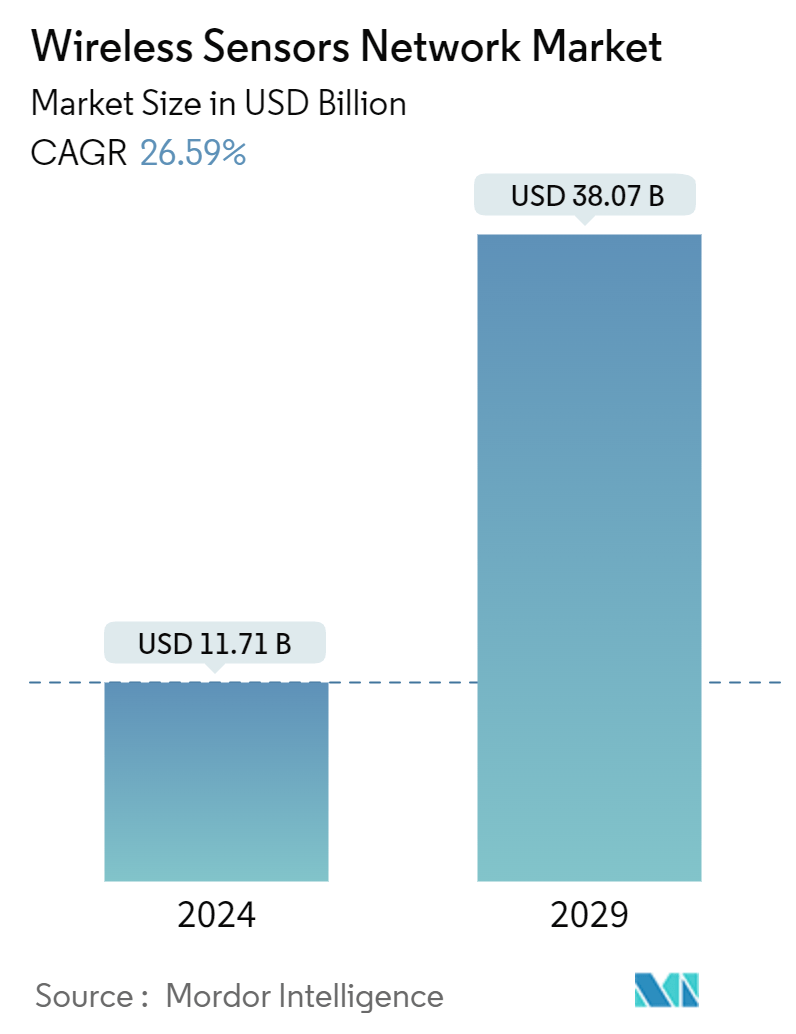Market Size of Wireless Sensors Network Industry

| Study Period | 2019 - 2029 |
| Market Size (2024) | USD 11.71 Billion |
| Market Size (2029) | USD 38.07 Billion |
| CAGR (2024 - 2029) | 26.59 % |
| Fastest Growing Market | Asia Pacific |
| Largest Market | North America |
| Market Concentration | Low |
Major Players
*Disclaimer: Major Players sorted in no particular order |
Wireless Sensors Network Market Analysis
The Wireless Sensors Network Market size is estimated at USD 11.71 billion in 2024, and is expected to reach USD 38.07 billion by 2029, growing at a CAGR of 26.59% during the forecast period (2024-2029).
There are many applications of wireless sensor networks in robotics, such as advanced robotic sensing, multiple robot coordination, robot planning and navigation, and robot localization. Using wireless sensor networks helps emergency response robots to be conscious of conditions, such as electromagnetic field monitoring, forest fire detection, etc.
- The growing automation and robotics industry, increasing demand for a wireless sensor network in asset monitoring, security, and transportation, and improved reliability with communication technology advancements are the significant factors driving the market for wireless sensor networks (WSN).
- Owing to the increased government regulation for the increased use of sensors for safety, the demand for wireless sensors is growing, for instance, in areas with challenging environmental conditions, such as extremely high pressure and high temperature. With the help of wireless sensors, it becomes easy to control and monitor the facility from a safe distance continually. They help acquire data from locations that are difficult to access.
- The rising adoption of IoT (Internet-of-Things) is another major factor driving the market's growth. This growth in IoT-connected devices is projected to fuel the demand for wireless sensor networks.
- Sensor manufacturers heavily invest in technology to cater to emerging verticals, such as smart cities and autonomous vehicles, which are substantially dependent on wireless technologies. Innovation in sensor technologies, such as intelligent sensors, is expected to support the rapid adoption of wireless technologies in the market. All these factors are expected to contribute to the growth of the wireless sensor network market.
- Despite their highly practical usefulness, there are some challenges in using wireless sensor network systems. There are vast differences in the scale of such sensor networking systems, as the number of sensor nodes may vary from a few to several. An adjustment also follows this in the density of deployment. The software and hardware design needs to be optimized to operate effectively for the task at hand, given that wireless sensor nodes have to function on an insufficient power supply.
- WSN has several constraints like power supply, storage, and a large number of algorithms, so there is a serious challenge in the maintenance of all these. Like all internet-dependent applications, WSN also has an insecurity scare. In order to combat data thefts in all possible ways, it is necessary to implement appropriate data transmission management.
Wireless Sensors Network Industry Segmentation
A wireless sensor network (WSN) is an infrastructureless wireless network deployed in several wireless sensors, ad hocly monitoring their physical and environmental conditions. The WSN has sensor nodes connected to an onboard processor for ecological management and monitoring in a specific area. They are connected to the base station of the WSN system, where processing takes place. A base station on the WSN system has an internet connection to share data.
The wireless sensors network market is segmented by end user (military and security, medical, transportation and logistics, oil and gas, waste and wastewater, consumer packaged goods [food and beverage], and other end users) and geography (North America [United States, Canada], Europe [United Kingdom, Germany, France, Rest of Europe], Asia-Pacific [China, India, Japan, Rest of Asia-Pacific], Latin America [Brazil, Mexico, Argentina, Rest of Latin America], Middle East and Africa [United Arab Emirates, Saudi Arabia, South Africa, Rest Middle East and Africa]. The market size and forecasts are provided in terms of value (USD) for all the above segments.
| By End-user | |
| Military and Security | |
| Medical | |
| Transportation and Logistics | |
| Oil and Gas | |
| Water and Wastewater | |
| Consumer Packaged Goods (Food and Beverage) | |
| Other End-users |
| By Geography*** | |||||
| |||||
| |||||
| |||||
| Australia and New Zealand | |||||
| |||||
|
Wireless Sensors Network Market Size Summary
The wireless sensor network market is poised for significant growth, driven by the increasing demand for automation and advancements in communication technologies. These networks find extensive applications in robotics, asset monitoring, security, and transportation, enhancing capabilities such as advanced robotic sensing and emergency response. The rise of IoT-connected devices further propels the market, as sensor manufacturers invest in technologies for smart cities and autonomous vehicles. Despite challenges like power supply constraints and security concerns, the market continues to expand, with innovations in intelligent sensors supporting the adoption of wireless technologies.
In the healthcare sector, wireless sensor networks are emerging as a crucial component of next-generation systems, offering solutions to challenges like rising costs and staffing shortages. These networks enable real-time health monitoring through wearable sensors, facilitating improved healthcare services and disease prevention. The integration of IoT and telemedicine is enhancing the monitoring and management of health conditions. North America is a key market, driven by advancements in healthcare infrastructure and the adoption of smart technologies. The market is competitive, with strategic investments and collaborations among players like STMicroelectronics and NXP Semiconductors, further fueling growth and innovation.
Wireless Sensors Network Market Size - Table of Contents
-
1. MARKET DYNAMICS
-
1.1 Market Overview
-
1.2 Industry Attractiveness - Porter's Five Forces Analysis
-
1.2.1 Bargaining Power of Suppliers
-
1.2.2 Bargaining Power of Consumers
-
1.2.3 Threat of New Entrants
-
1.2.4 Threat of Substitutes
-
1.2.5 Intensity of Competitive Rivalry
-
-
1.3 Technology Snapshot
-
1.3.1 Topology
-
1.3.1.1 Star
-
1.3.1.2 Mesh
-
1.3.1.3 Hybrid
-
1.3.1.4 Tree
-
-
1.3.2 Sensors
-
1.3.2.1 MEMS
-
1.3.2.2 CMOS-based Sensors
-
1.3.2.3 LED Sensors
-
-
1.3.3 Network Technology (Connectivity)
-
1.3.3.1 Wireless HART
-
1.3.3.2 ZigBee
-
1.3.3.3 Wi-Fi
-
1.3.3.4 IPv6
-
1.3.3.5 Bluetooth
-
1.3.3.6 Dash 7
-
1.3.3.7 Z-Wave
-
-
-
1.4 Impact of Macro Economic Trends on the Market
-
-
2. MARKET SEGMENTATION
-
2.1 By End-user
-
2.1.1 Military and Security
-
2.1.2 Medical
-
2.1.3 Transportation and Logistics
-
2.1.4 Oil and Gas
-
2.1.5 Water and Wastewater
-
2.1.6 Consumer Packaged Goods (Food and Beverage)
-
2.1.7 Other End-users
-
-
2.2 By Geography***
-
2.2.1 North America
-
2.2.1.1 United States
-
2.2.1.2 Canada
-
-
2.2.2 Europe
-
2.2.2.1 United Kingdom
-
2.2.2.2 Germany
-
2.2.2.3 France
-
-
2.2.3 Asia
-
2.2.3.1 China
-
2.2.3.2 Japan
-
2.2.3.3 India
-
-
2.2.4 Australia and New Zealand
-
2.2.5 Latin America
-
2.2.5.1 Brazil
-
2.2.5.2 Mexico
-
2.2.5.3 Argentina
-
-
2.2.6 Middle East and Africa
-
2.2.6.1 United Arab Emirates
-
2.2.6.2 Saudi Arabia
-
2.2.6.3 South Africa
-
-
-
Wireless Sensors Network Market Size FAQs
How big is the Wireless Sensors Network Market?
The Wireless Sensors Network Market size is expected to reach USD 11.71 billion in 2024 and grow at a CAGR of 26.59% to reach USD 38.07 billion by 2029.
What is the current Wireless Sensors Network Market size?
In 2024, the Wireless Sensors Network Market size is expected to reach USD 11.71 billion.

